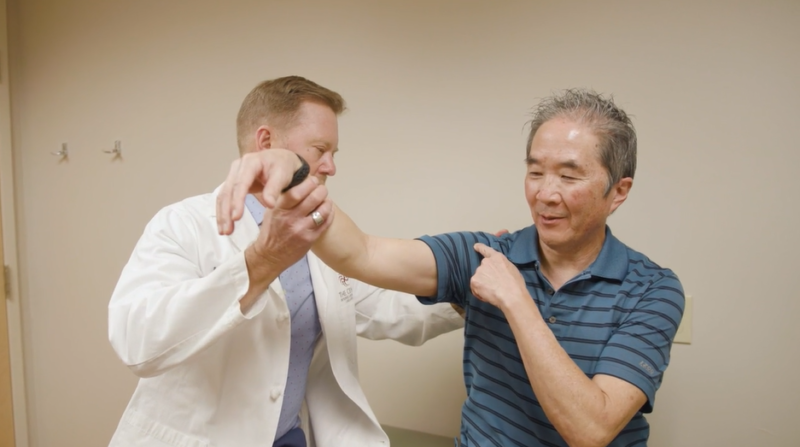
Shoulder arthroplasty can help relieve pain in your shoulder and enable you to live a more active life or complete activities of daily living. Advanced anesthesia techniques allow the vast majority of these shoulder replacement surgeries to occur in surgery centers, rather than in hospitals, going home the same day to recover. Generally, it is done after conservative treatment options, such as medications, injections, and physical therapy have not helped. If you and your orthopedic surgeon have decided that you are a good candidate for shoulder joint replacement, you are in good company. Over 50,000 people in the U.S. have a shoulder replacement each year.
CAUSES AND RISK FACTORS
Shoulder injuries
Shoulder injuries can result from genetic factors, overuse activities, or a single traumatic injury. Many repetitive sporting activities that use the arm overhead, such as tennis, swimming, and baseball, can result in injury to the capsule, ligaments, and muscles that surround the shoulder joint. Lifting weights too frequently or incorrectly can also lead to a shoulder injury. Immediate effects of these injuries are pain, swelling, and instability of the shoulder.
Depending on the severity of the injury, the function of the injured shoulder can often be greatly compromised. Unfortunately, some structures of the shoulder joint do not readily heal themselves. Even with treatment, such as physical therapy, the symptoms remain. Therefore, without surgical intervention, many individuals are unable to participate in sports or daily activities.
Osteoarthritis
This is an age-related “wear and tear” type of arthritis and a common reason that people have shoulder replacement surgery. The cartilage that cushions the bones wears away causing the bones to rub against one another. Over time, the shoulder joint slowly becomes stiff and painful. In order to improve the function of the shoulder and restore motion, replacing the surfaces of the shoulder joint can be the most effective treatment to improve function and relieve pain.
TOTAL SHOULDER REPLACEMENT
An anatomical total shoulder replacement is when the damaged parts of the shoulder are removed and replaced with artificial components. Both the humeral head (upper arm bone) and the glenoid (shoulder socket) are replaced with anatomically matching metal and plastic implants.
REVERSE TOTAL SHOULDER REPLACEMENT
This procedure is the opposite of an anatomical shoulder replacement where the socket and metal ball are switched. A reverse total shoulder replacement relies on the deltoid muscle, instead of the rotator cuff, to power and position the arm.
INPATIENT VS OUTPATIENT SURGERY

Frequently Asked Questions About Shoulder Replacement
When can I exercise after surgery?
Other than the exercises prescribed for your shoulder, no other exercise program should be initiated until at least after your first postoperative visit. Most shoulder replacement surgery patients are able to return to lower extremity strengthening exercises, such as riding a stationary bike, within four weeks of surgery.
How much assistance will I require postoperatively?
The level of assistance required depends on the general level of medical health and mobility of the patient. Your specific needs will be addressed prior to shoulder replacement surgery and immediately after surgery. After discharge, most patients manage daily activities with minimal or no assistance. However, patients with greater needs because of decreased mobility or other health issues may require at home assistance from relatives or a home health service. We are accustomed to working with these organizations and arranging care if needed.
Shoulder specialist, Dr. Scott Jacobsen, describes the anesthesia and pain management for patients during this shoulder replacement surgery. This regimen creates a very smooth, safe, and efficient procedure for patients.
Video transcription:
“Our ability to manage pain has improved so much over the last 10 to 15 years that the vast majority of shoulder arthroplasty now is done as an outpatient procedure. One of the interventions that has been incredibly helpful in allowing that to happen is a regional nerve block that’s admitted by the anesthesiologist right before we go back to surgery. The benefit of the block is that we can give them a very light, general anesthetic with no narcotics added. That makes a huge difference in how quickly the patient wakes up. They become alert within the first 30 to 45 minutes and do not have any pain.
The biggest focus in the first 24 hours is to make that transition period, when the block wears off, as smooth as possible. The block lasts for 16 to 18 hours. Pain medicine is started the night of surgery before any pain even starts to happen. This regimen has created a very smooth and efficient way that’s comfortable for most patients. There have been excellent studies as well, looking at the safety profile of outpatient versus inpatient shoulder arthroplasty. There’s no difference in complication rates. Patients, in general, are very pleased not to spend a night in a hospital. They’re more than happy to be done as an outpatient category.”
We’ve also put together a free guide to help you better understand joint replacement preparation, surgery, and recovery. If joint replacement surgery is the best solution for you, The Center’s orthopedic surgeons and support staff are ready to help you prepare for surgery and plan for a successful recovery.
Click below to sign up and receive our free joint replacement guide.





